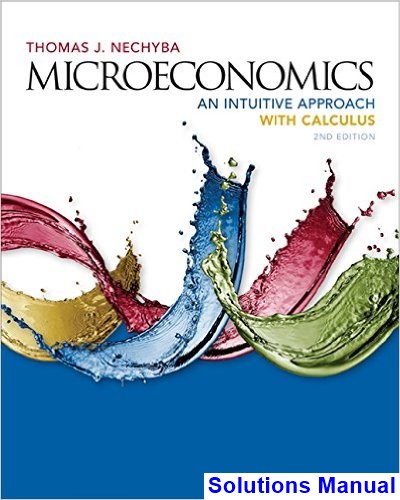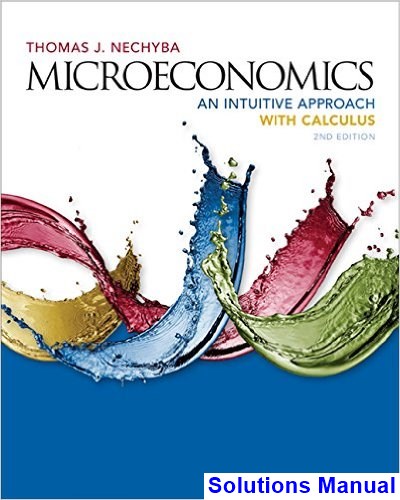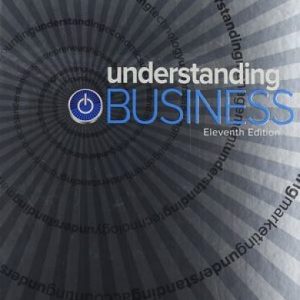This is completed downloadable of Microeconomics An Intuitive Approach with Calculus 2nd Edition Thomas Nechyba Solutions Manual

Product Details:
- ISBN-10 : 1305650468
- ISBN-13 : 978-1305650466
- Author: Thomas Nechyba
Should you rent a car or take taxis while on vacation? How do coupons change demand? Should we subsidize oil drilling to make us less dependent on foreign oil? MICROECONOMICS: AN INTUITIVE APPROACH WITH CALCULUS, 2E explains the economic theory underlying day-to-day choices. The A sections of each chapter introduce concepts using intuition, conversational writing, everyday examples, and graphs. The B sections cover the same concepts with accessible mathematical analyses that assume you have one semester of single-variable calculus. MindTap is now available with interactive, animated Video Graph Presentations that bring each graph from the book to life. Improved navigation and chapter markers let you use this resource with ease. New Progression Graphs in the eReader separate economic concept graphs into finite steps that you can walk through at your own pace.
Table contents:
- Ch 1: Introduction
- 1.1: What Is Microeconomics?
- 1.2: Economics, Incentives, and Economic Models
- 1.3: Predicting versus Judging Behavior and Social Outcomes
- 1.4: The “Non-Dismal” Science: Some Basic Lessons
- 1.5: The Plan for this Book
- 1.6: Succeeding in this Course
- 1.7: Onward
- Part 1: Utility-Maximizing Choice: Consumers, Workers, and Savers
- Ch 2: A Consumer’s Economic Circumstances
- Ch 2: Introduction
- 2A: Consumer Choice Sets and Budget Constraints
- 2B: Consumer Choice Sets and Budget Equations
- Ch 2: Conclusion
- Ch 2: End-of-Chapter Exercises
- Ch 3: Economic Circumstances in Labor and Financial Markets
- Ch 3: Introduction
- 3A: Budgets for Workers and Savers
- 3B: Choice Sets and Budget Equations for Workers and Savers
- Ch 3: Conclusion
- Ch 3: End-of-Chapter Exercises
- Ch 4: Tastes and Indifference Curves
- Ch 4: Introduction
- 4A: The Economic Model of Tastes
- 4B: Tastes and Utility Functions
- Ch 4: Conclusion
- Appendix: Some Basics of Multivariable Calculus
- Ch 4: End-of-Chapter Exercises
- Ch 5: Different Types of Tastes
- Ch 5: Introduction
- 5A: Different Types of Indifference Maps
- 5B: Different Types of Utility Functions
- Ch 5: Conclusion
- Appendix: The Calculus of Elasticities of Substitution
- Ch 5: End-of-Chapter Exercises
- Ch 6: Doing the “Best” We Can
- Ch 6: Introduction
- 6A: Choice: Combining Economic Circumstances with Tastes
- 6B: Optimizing within the Mathematical Model
- Ch 6: Conclusion
- Appendix: Optimization Problems with Kinked Budgets
- Ch 6: End-of-Chapter Exercises
- Ch 7: Income and Substitution Effects in Consumer Goods Markets
- Ch 7: Introduction
- 7A: Graphical Exposition of Income and Substitution Effects
- 7B: The Mathematics of Income and Substitution Effects
- Ch 7: Conclusion
- Ch 7: End-of-Chapter Exercises
- Ch 8: Wealth and Substitution Effects in Labor and Capital Markets
- Ch 8: Introduction
- 8A: Wealth Effects, Substitution Effects, and Endowments
- 8B: Constrained Optimization with Wealth Effects
- Ch 8: Conclusion
- Ch 8: End-of-Chapter Exercises
- Ch 9: Demand for Goods and Supply of Labor and Capital
- Ch 9: Introduction
- 9A: Deriving Demand and Supply Curves
- 9B: Demand and Supply Functions
- Ch 9: Conclusion
- Ch 9: End-of-Chapter Exercises
- Ch 10: Consumer Surplus and Deadweight Loss
- Ch 10: Introduction
- 10A: Measuring Consumer Welfare in Dollars
- 10B: The Mathematics of Consumer Welfare and “Duality”
- Ch 10: Conclusion
- Appendix: Shephard’s Lemma and Roy’s Identity
- Ch 10: End-of-Chapter Exercises
- Part 2: Profit-Maximizing Choice: Producers (or “Firms”)
- Ch 11: One Input and One Output: A Short-Run Producer Model
- Ch 11: Introduction
- 11A: A Short-Run One-Input/One-Output Model
- 11B: The Mathematics of the Short-Run Model
- Ch 11: Conclusion
- Ch 11: End-of-Chapter Exercises
- Ch 12: Production with Multiple Inputs
- Ch 12: Introduction
- 12A: An Intuitive Development of the Two-Input Model
- 12B: The Mathematics behind the Multiple-Input Model
- Ch 12: Conclusion
- Appendix: Properties of Expenditure and Profit Functions
- Ch 12: End-of-Chapter Exercises
- Ch 13: Production Decisions in the Short and Long Run
- Ch 13: Introduction
- 13A: Changes in Producer Behavior as Conditions Change
- 13B: Transitioning from Short- to Long-Run Mathematically
- Ch 13: Conclusion
- Ch 13: End-of-Chapter Exercises
- Part 3: Competitive Markets and the “Invisible Hand”
- Ch 14: Competitive Market Equilibrium
- Ch 14: Introduction
- 14A: Equilibrium: Combining Demand and Supply Curves
- 14B: The Mathematics of Industry (or Market) Equilibrium
- Ch 14: Conclusion
- Ch 14: End-of-Chapter Exercises
- Ch 15: The “Invisible Hand” and the First Welfare Theorem
- Ch 15: Introduction
- 15A: Welfare Analysis in Equilibrium
- 15B: Equilibrium Welfare Analysis: Preliminaries and an Example
- Ch 15: Conclusion
- Ch 15: End-of-Chapter Exercises
- Ch 16: General Equilibrium
- Ch 16: Introduction
- 16A: A Graphical Exposition of General Equilibrium
- 16B: The Mathematics of Competitive General Equilibrium
- Ch 16: Conclusion
- Appendix: Core Convergence
- Ch 16: End-of-Chapter Exercises
- Ch 17: Choice and Markets in the Presence of Risk
- Ch 17: Introduction
- 17A: An Intuitive Model of Choice in the Presence of Risk
- 17B: The Mathematics of Choice in the Presence of Risk
- Ch 17: Conclusion
- Appendix 1: Expected Utility and the Independence Axiom
- Appendix 2: The Allais Paradox and “Regret Theory”
- Ch 17: End-of-Chapter Exercises
- Part 4: Distortions of the “Invisible Hand” in Competitive Markets
- Ch 18: Elasticities, Price-Distorting Policies, and Non-Price Rationing
- Ch 18: Introduction
- 18A: Interactions of Markets and Price-Distorting Policies
- 18B: The Mathematics of Elasticities and Price Distortions
- Ch 18: Conclusion
- Ch 18: End-of-Chapter Exercises
- Ch 19: Distortionary Taxes and Subsidies
- Ch 19: Introduction
- 19A: Taxes and Subsidies in Competitive Markets
- 19B: The Mathematics of Taxes (and Subsidies)
- Ch 19: Conclusion
- Ch 19: End-of-Chapter Exercises
- Ch 20: Prices and Distortions across Markets
- Ch 20: Introduction
- 20A: Exporters, Importers, and Speculators
- 20B: The Mathematics of Trading across Markets
- Ch 20: Conclusion
- Ch 20: End-of-Chapter Exercises
- Ch 21: Externalities in Competitive Markets
- Ch 21: Introduction
- 21A: The Problem of Externalities
- 21B: The Mathematics of Externalities
- Ch 21: Conclusion
- Appendix: Fundamental Non-Convexities in the Presence of Externalities
- Ch 21: End-of-Chapter Exercises
- Ch 22: Asymmetric Information in Competitive Markets
- Ch 22: Introduction
- 22A: Asymmetric Information and Efficiency
- 22B: Insurance Contracts with Two Risk Types
- Ch 22: Conclusion
- Ch 22: End-of-Chapter Exercises
- Part 5: Distortions of the “Invisible Hand” from Strategic Decisions
- Ch 23: Monopoly
- Ch 23: Introduction
- 23A: Pricing Decisions by Monopolist
- 23B: The Mathematics of Monopoly
- Ch 23: Conclusion
- Appendix: Deriving a “Reduced Form” Utility Function from Separable Preferences
- Ch 23: End-of-Chapter Exercises
- Ch 24: Strategic Thinking and Game Theory
- Ch 24: Introduction
- 24A: Game Theory under Complete Information
- 24B: Game Theory under Incomplete Information
- Ch 24: Conclusion
- Appendix: Infinitely Repeated Games and the Folk Theorem
- Ch 24: End-of-Chapter Exercises
- Ch 25: Oligopoly
- Ch 25: Introduction
- 25A: Competition and Collusion in Oligopolies
- 25B: The Mathematics of Oligopoly
- Ch 25: Conclusion
- Ch 25: End-of-Chapter Exercises
- Ch 26: Product Differentiation and Innovation in Markets
- Ch 26: Introduction
- 26A: Differentiated Products and Innovation
- 26B: Mathematical Modeling of Differentiated Product Markets
- Ch 26: Conclusion
- Ch 26: End-of-Chapter Exercises
- Ch 27: Public Goods
- Ch 27: Introduction
- 27A: Public Goods and Their Externalities
- 27B: The Mathematics of Public Goods
- Ch 27: Conclusion
- Ch 27: End-of-Chapter Exercises
- Ch 28: Governments and Politics
- Ch 28: Introduction
- 28A: The Economic Way of Thinking about Politics
- 28B: An Exposition of Arrow’s Impossibility Theorem
- Ch 28: Conclusion
- Ch 28: End-of-Chapter Exercises
- Part 6: Considering How to Make the World a Better Place
- Ch 29: What Is Good? Challenges from Psychology and Philosophy
- Ch 29: Introduction
- 29A: Who Are We Really, and What Is It All About?
- 29B: Some Tools in the Search for “What Is Good”
- Ch 29: Conclusion
- Ch 29: End-of-Chapter Exercises
- Ch 30: Balancing Government, Civil Society, and Markets
- Ch 30: Introduction
- Glossary
- Index





